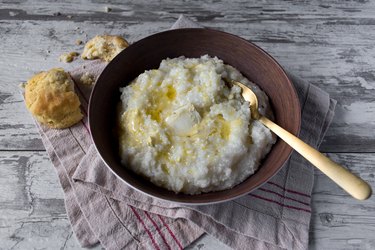
Is the sugar in grits a reason for concern? After all, this Southern breakfast staple is a lot healthier than cereals, waffles or even pancakes. Despite its high carb content, it's low in sugar and can make it easier to boost your fiber intake.
Are Grits Healthy?
Video of the Day
With their mild flavor and smooth consistency, grits make a delicious meal for breakfast. This classic dish is ready in minutes and can be prepared with water or milk. Rich in B-complex vitamins and fiber, it fills you up quickly and boosts your energy.
Video of the Day
Traditionally, this breakfast dish is made from boiled cornmeal. It can be served with sugar or salt — either way, it melts in your mouth and delights your taste buds. Several varieties of grits exist, including instant, hominy, stone-ground and regular grits, and each has a different nutritional value.
White corn grits cooked with water, for example, have only 70 calories per serving (half a cup), according to the USDA. They are a good source of iron and contain zero sugar. The problem is that many people don't particularly enjoy the taste of plain grits, so they add bacon, eggs, butter, cheese and other extras that turn it into a calorie bomb.
Let's say you make grits with 1 tablespoon of butter, two eggs, 1 cup of whole milk and two slices of bacon. Butter has around 100 calories per tablespoon. One egg boasts 60 calories, so two eggs will provide 120 calories. Whole milk delivers 150 calories per cup, while two slices of fried bacon contain 90 calories.
These ingredients provide an additional 460 calories — on top of those in plain grits. Sure, you don't need to eat everything at once, but you'll still get more carbs, fats and calories compared to regular grits cooked in water.
The Sugar in Grits
Plain grits are low in sugar, making them ideal for dieters and people with diabetes. Their sugar content may increase, depending on the ingredients used, however. Yellow corn grits, for example, provide the following nutrients per serving (half a cup):
- 76 calories
- 1.4 grams of protein
- 0.5 grams of fat
- 16.1 grams of carbs
- 0.8 grams of fiber
- 0.1 grams of sugar
- 4 percent of the DV (daily value) of iron
- 1 percent of the DV of potassium
- 6 percent of the DV of selenium
- 10 percent of the DV of vitamin B1
- 8 percent of the DV of folate
- 229.5 micrograms of lutein and zeaxanthin
White corn grits are slightly higher in calories, but they still have only 0.2 grams of sugar per serving. Considering these facts, it's fair to say that grits are a healthy choice, whether you want to slim down or keep your blood sugar in check. Just make sure you don't add dried fruits, chocolate toppings and other sugary extras.
Grits and Diabetes
As the American Diabetes Association points out, not all carbs are created equal. If you have diabetes, choose foods rich in complex carbs and fiber and low in simple sugars.
Grits contain little or no sugar, but they're quite high in carbs. Their fiber content is low. What this means is that you can enjoy them as an occasional treat as long as you keep an eye on your portions.
The experts at Harvard Health Publishing recommend choosing whole grains over grits. Whole oats, whole wheat and other unprocessed grains are higher in fiber and have a lower glycemic index compared to this Southern dish. The glycemic index (GI) is a number assigned to foods that measures their impact on blood glucose levels. Foods with a high GI, such as white bread and cookies, tend to cause blood sugar spikes followed by crashes.
Cornmeal has a medium glycemic index of 56 to 69, according to Diabetes Canada. Therefore, it may cause a moderate increase in blood sugar levels and shouldn't be consumed regularly. Whole barley, bulgur, quinoa and whole pasta, on the other hand, have a low GI (below 55) and make a better choice for those with diabetes.
Grits' glycemic index depends largely on the processing method and the ingredients used when preparing a meal with it. A small study published in Food Science & Nutrition in March 2016 found that different types of corn flour and grits affect blood sugar differently. Fermented corn grits had a lower glycemic index (65.4) compared to whole corn flour and grits (94 to 109), as the researchers noted. Sugar, whole milk, honey and other ingredients may increase their glycemic index, too.
If you have diabetes, you may eat grits from time to time. Keep your portions small and refrain from adding sugary ingredients. Consider using cinnamon, nutmeg, raw cocoa, vanilla essence or stevia for extra flavor.
- USDA: "Corn Grits, White, Enriched"
- USDA: "Butter"
- USDA: "Eggs"
- USDA: "Whole Milk"
- USDA: "Fried Bacon"
- USDA: "Yellow Corn Grits"
- USDA: "White Corn Grits"
- American Diabetes Association: "Get to Know Carbs"
- Harvard.edu: "Healthy Diet: Is Glycemic Index the Key?"
- Diabetes Canada: "Glycemic Index Food Guide"
- Food Science & Nutrition: "Glycemic Responses to Maize Flour Stiff Porridges Prepared Using Local Recipes in Malawi"